A Mazda race car long thought to have been lost to history surfaced. The Mazda 254i not only competed in the 1982 running of the 24 Hours of Le Mans, but represents the last of its breed. It was the final iteration of Mazda’s Le Mans race cars based on a production RX-7, and now the last surviving example has been rediscovered.
Though a small company from Hiroshima, Mazda has never shied away from challenging the most grueling motorsports contests the world’s had to offer. Though Mazda’s endurance program came from humble beginnings, the introduction of the SA22C RX-7 in 1979 gave its motorsports arm a chance to build a racer on an existing sports car platform.
Due to their success at the 24 Hours of Daytona, these cars were built to IMSA GTX rules, which allowed the cars to run in various endurance races, and were more or less identical to the legendary Group 5 super silhouette spec. That gave the RX-7s the signature box flares, a swooping elongated tail, and giant wing. For the next several years, the team learned many hard lessons about Le Mans, evolving the cars each time.
In 1982, Mazda ran the ultimate iteration of these enduro RX-7s, a pair of race cars dubbed the Mazda 254i, at Le Mans. That year, the No. 82 car driven by Yojiro Terada, Allan Mofatt, and Takashi Yorino, succeeded in the team’s long-sought goal of simply finishing the backbreaking race, placing 14th overall.
The second car, No. 83 driven by Tom Walkinshaw, Chuck Nicholson, and Peter Lovett, ran as high as 8th place at one point but logged a DNF, retiring after 180 laps. With the FIA introducing a Group C class for prototypes that same year, teams quickly switched over and Mazda was no exception, debuting the 717C the in 1983. From there, one can trace a direct lineage to the Le Mans-winning 787B of 1991.
And while everyone remembers the race-winning 787B, the 254i largely faded from memory. After Le Mans, the pair went back to Japan and competed in various races on the JPSC calendar. One was painted pink and one was painted yellow but the line of which became which was a bit hazy. The former No. 83 finished its last race at the Fuji 1000km in 1984, retired, and fell off the radar.
In the 35 years since, only die-hard Mazdafarians and enduro fanatics cared much about the car, even if the Group 5 RX-7 did inspire kaido racer tribute builds and the Mazdaspeed A-Spec body kit for the FD RX-7. Then last year, a Mazda 254i was unearthed in Okayama, one of Japan’s comparatively remote western prefectures.
It was confirmed by Tachimoto-san, the chief mechanic at Mazdaspeed at the time of the 254i, to be the No. 83 car due to its brake system and rear suspension. He also confirmed that cash-strapped Mazdaspeed at the time simply reused a predecessor 253i chassis with new bodywork to create this car.
Isami Amemiya, head of Japan’s most famous Mazda tuning house, took a bullet train to Okayama to see the car in person. He accompanied it as it was loaded onto a flatbed and shipped to Powercraft, a specialty shop in Gotemba, Shizuoka that specializes in composites. There, the bodywork will be restored, while Amemiya will build the car’s 13B rotary engine.
Though it ran just a dual-rotor 13B, output was estimated at about 300PS (296 horsepower), with the car weighing approximately 2,125 pounds at the time. Underneath the aero work, one can still see the stock RX-7 doors.
Upon closer inspection it was revealed that the car was once painted gold, and also pink. That confirmed that it was once the No. 38 car that wore the famous black-and-gold Jun livery, and was in fact the pink car that raced in JSPC.
Sadly, during the JSPC years the former No. 82 Le Mans finisher was destroyed in a crash at Fuji Speedway’s 100R corner. This car, however, has never seen a crash, and, amazingly remained in tact all this time. After restoration, it can join Nissan’s Group 5 racers as part of Japan’s rich motorsports history. Long thought to be lost, it is now the only known Group 5 Mazda left in the world and an important step in Mazda’s illustrious endurance racing heritage.
Images: Powercraft, Best Car


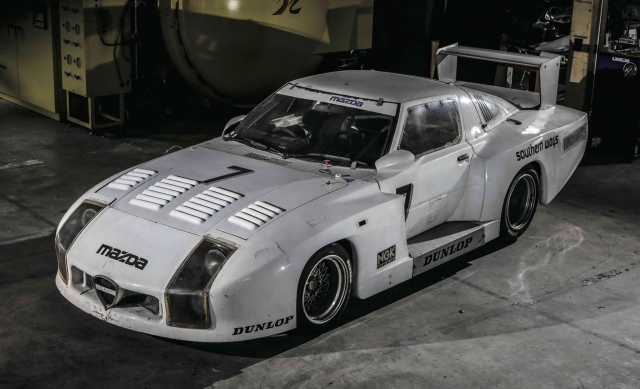


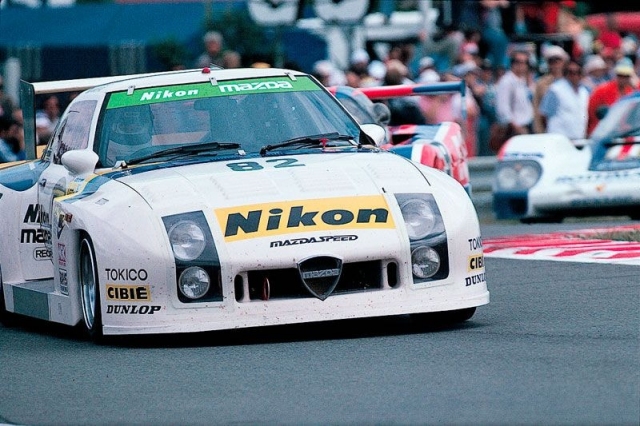
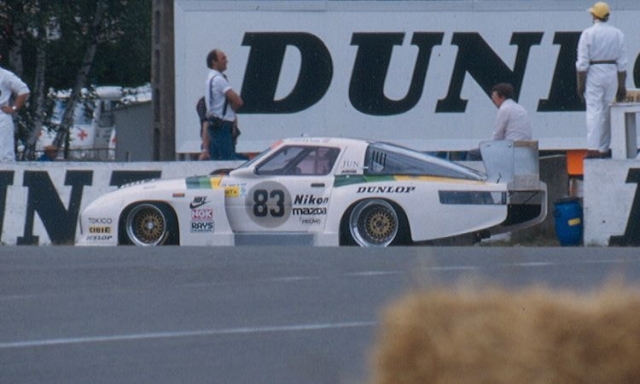


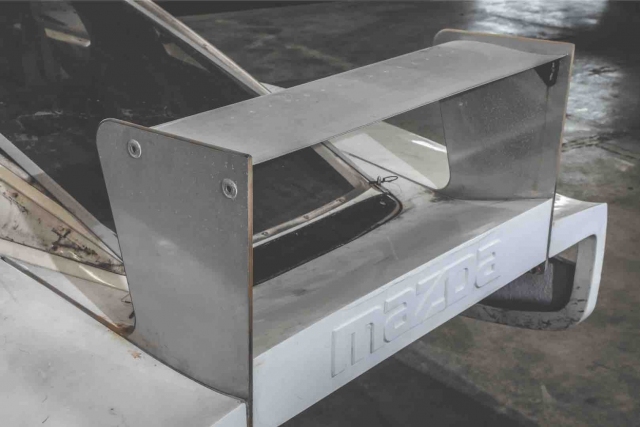
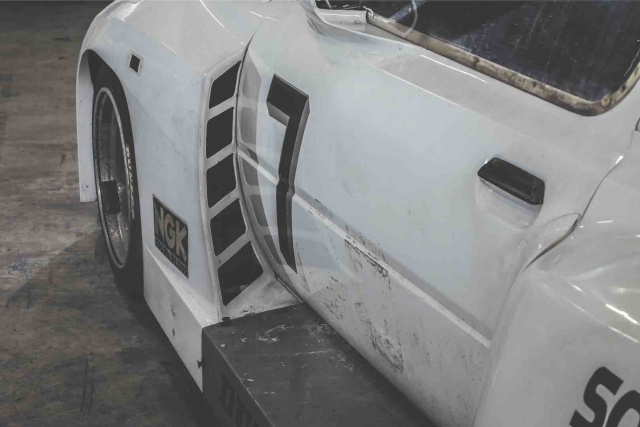



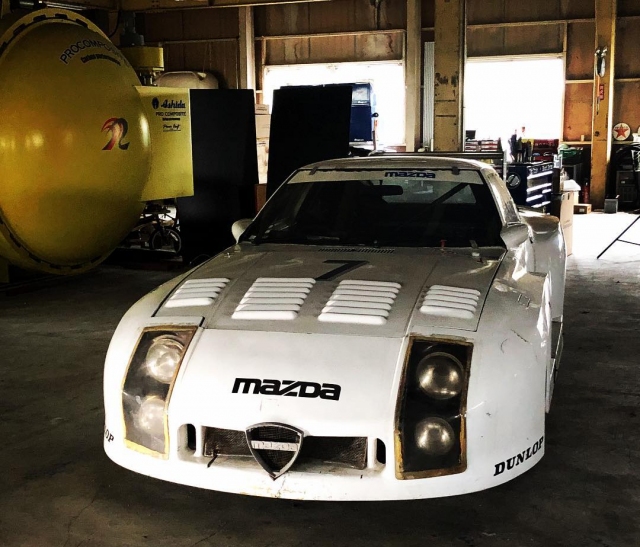




Awsome story,cant wait to see it running again!!!
Holy Hell, what a beautiful Machine.
Do we see an upcoming RE-Amemiya 2020 Tokyo Auto Salon Booth star here? 🙂
The first generation RX-7 actually started production in 1978. It’s cool that it was found and will be restored. Found a YouTube video about it.
https://youtu.be/TAtXda-uISs
There was a lot of enthusiasts kicking up a stink on FB about this getting restored. They argue that it should stay as is because it has battle scars and damage acquired while racing. But someone has gone to the effort to make sure only a few racing stickers remain (why?) and painted it a dirty white. Was this owned privately for the last 30 odd years? And if so, did the owner race it? Not sure why these questions are important, I’m just curious.
It seems that Mazda has already decided to restore it regardless…
I don’t see why it should be preserved in its abandoned state unless the owner was someone really special.
An old race car should be restored to a notable point in its life. A safe bet would be Mazda bringing back to its initial Le Mans configuration, though I would like to see it in the black and gold livery.
Yeah I’m not biased either way. Good to see these old cars getting attention regardless.
It’s amazing how old Japanese cars can stir up such emotions in people nowadays (i’m guilty just like the rest of us). It’s just a shame that when I get to a point of having disposable income to spend on said JNC’s, they sky rocket in value… damn.
The good thing about an old race car beeing restored by the factory and big names, is that we will most probably see it back on track and display at other occasions in the future which is way better than keeping it in it’s abused state and just putting it on a museum display.
The only thing i wonder is why they didn’t hand the engine to JUN Automechanic when they used to work on this in the past, rather than RE-Amemiya? or was this a different “JUN”?
The Jun on this car is a clothing company.
There was a lot of enthusiasts kicking up a stink on FB about this getting restored. They argue that it should stay as is because it has battle scars and damage acquired while racing. But someone has gone to the effort to make sure only a few racing stickers remain (why?). Was this owned privately for the last 30 odd years? And if so, did the owner race it? Not sure why these questions are important, I’m just curious.
It seems that Mazda has already decided to restore it regardless…
How do you misplace sumthing like that? I would know where it is at all times, laying in my bed where I left it this morning.
PUERTO RICO AND ROTARY S AHHHH,,,SWEET MEMORIES GROING UP DOWN THERE HEARING THE SWEET SOUNDS OF RX3, RX4, RX7, WE GOT THEM ALL…
Hasta el 8 bastos braaap ratatatata!!!!
Looks beautiful!
Just be sure to not let Top Gear drive it Mazda!
Awesome to see this machine back !!
Great story. Alan Moffatt, originally from Canada, had great success with an RX7 in Australian racing, and is still with us. He will be especially pleased at the news of this discovery.
I was in LeMans 24 in 1982. I was in the Mazda hot pits for about ½ hour which seemed like an eternity. Had taken 2 quarters of French and convinced the “gendarmes” to let me in. My excuse was that I was reporting for a Mazda magazine in California. I was., it was Rotary Review. I wrote in the closing sentence that Mazda should just join two 13B engines and come back with a prototype.
During one of the pit stops of car #82, I moved to the back to take a close up of the exhaust. Had two Olympus 35mm reflex cameras with a tele and a zoom. I had noticed the megaphone exhaust at the rear center and wanted to “feel” the engine. Yojiro Terada climbed into the car at driver’s change and he fired up the 13B before the crew dropped the air jacks. I was thrown back seven feet away and I was sent flying back into the pavement full of premix fumes.
The cars were beautiful with their NIKON logos on the windshield. Not explained fully in the article is that the cars were prepared for the IMSA GTO class and FIA put them in GTX with the turbo Porsches at the last minute. Smelled like politics but then thats the French authorities for you.
Another unknown fact is that in the last 2 hours of the race, Terada was lapping the brand new Porsche 962s right in front of the main stands. GLORIOUS !! The 962’s were all misfiring. They won due to early speed. Two more hours and #82 could have won or finished at the podium.
The two cars ran mechanical fuel injection for qualifying and 52mm Weber IDAs for the race. I have slides of all this. Will have to post them somewhere.
Got into racing stateside always remembering #82 and #83. I’m lucky to own 3 IMSA racers. Here is one for you to enjoy. The other two are in restoration.
https://www.facebook.com/media/set/?set=a.456910804323467.122353.270193212995228&type=3
Hello. And Bye.
I was there in LM 1982 and have beautiful photos of both cars including Mr Terada. What an experience to watch him pass the lead 962 in front of the stands. 💪 I even printed a 30”x42” poster of the event.